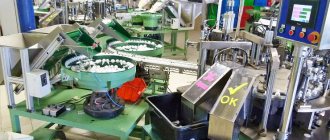To produce plastic cards you do not need to have special education or experience. The production process is not difficult to master, and the products are in great demand among most people. Today it is difficult to find a person who does not have at least one plastic card.
Such cards are issued not only by banks, but also by stores and large companies. Over time, cards wear out and require periodic replacement. This makes business even more attractive. Read the article about how such cards are made, what is needed for this and how much you can earn.
What is a plastic card
Plastic cards are made from PVC or other cheaper polymer materials and covered with a protective film coating. This product has a rectangular shape with rounded ends and a thickness of up to 1 mm. The cards are issued in the same size of 5.4x8.6 cm. In order for the cards to be readable, magnetic stripes, unique chips, barcodes and holograms are applied to them. Depending on the scope of the card, other additional elements may be applied to it.
Different types of cards have different manufacturing complexity, and for some types it is necessary to purchase additional equipment. Therefore, you should immediately decide and choose a suitable niche for work.
PVC cards
PVC is the most widely used material in the production of plastic cards.
Advantages of PVC:
- quite low cost
- ease of processing
- material suitable for sublimation printing
Disadvantages of PVC:
- short service life
- subject to wear and tear
- poor tolerance to temperature fluctuations
Despite the listed disadvantages and negative impact on the environment, PVC is the most popular material for the production of plastic cards due to its ease of processing and printing, as well as its reasonable price.
Product market analysis
Plastic cards have been used for more than 50 years, and in Russia for more than 20. They are actively produced all over the world, and their production in Russia is growing rapidly. Now plastic cards are in demand in:
- Service sector . These are various club cards, gift certificates, discount cards.
- Banking sector. These include various payment cards – credit and debit.
- Sales area. These are bonus, discount cards offered by shops, pharmacies, cafes and other establishments.
- Government agencies. Plastic cards are increasingly used as documents: driver's licenses, passports, identity cards, etc.
- Hotels, factories and offices. In such places, cards are used as keys or passes.
- Mobile communications. When purchasing a starter package with a SIM card from operators, the SIM is placed in a plastic card.
Clients rarely order a batch of cards once. Old cards become unusable over time and need to be updated.
There is high competition in this area, but there are enough orders. After all, the number of clients from different fields is very large. Therefore, it makes sense not to focus on just one area, but to develop and work in different directions.
Plastic card production technology
Card production is a simple process, but it requires strict adherence to technology and the correct selection of equipment. Plastic cards are produced in several stages. Some of them may differ depending on the purpose of the cards and the need for additional information or protection on them.
The first stage consists of creating a map layout on a computer and agreeing on the design and all the nuances with customers.
Second phase. With the help of a puncher, blanks are made for future cards. The equipment can be either mechanical or automatic. Automatic is more expensive, but will save time and increase production productivity.
The third stage of card production is printing on the product. It can be applied on both sides or only on one. It depends on the client's preferences and budget. The printing itself comes in several types, depending on the equipment used.
Print type:
- Stencil. Text and graphics are printed on the card using a silk plate and inks.
- Laser. Such printing is possible in large enterprises and is based on the light sensitivity of a special drum.
- Offset. This type of printing is the most popular. The coloring pigment is applied to the plastic in flat forms in several passes.
- Thermal printer. The image is applied using high temperatures.
Fourth stage. If the card consists of 2 parts, it is sintered. After this, the product is varnished or laminated. This increases the durability of the card.
The last stage of card production is personalization and application of additional protection and elements. Magnetic tape, barcode, and hologram are applied. The card can also be treated with ultraviolet light, embossed and metal sprayed.
The more complex the card protection, the more equipment is needed and the higher its price. Therefore, at the start of work, you should not purchase everything at once - it is better to start with simple orders and gradually expand.
Production of bank plastic cards
The production of plastic cards takes place in special process centers that have certification and access from banks. The most interesting thing is that such centers usually employ only a few people, and at the same time they make a fairly large number of cards.
As soon as you apply for a card at the bank, a 7-calendar day countdown begins during which the card is issued to you. Non-registered Momentum class cards are issued immediately at the bank. But why does it take so long to make personalized ones? Let's figure it out.
As you know, you need to make not only the plastic itself, but also an envelope that contains information about the bank account and, most importantly, a PIN code. The most interesting thing is that the envelopes themselves are initially produced sealed and without a PIN code. After which the computer generates the 4-digit PIN code itself and, using embossing and pressing, puts the code itself inside the sealed envelope using carbon paper inside.
That is why the center employees do not know what exactly the PIN code is for a particular card. To produce a bank plastic card, ready-made blanks are used. Many blanks already have a design. Usually these are standard classic cards that are issued to almost everyone.
On average, a card costs from 200 to 700 rubles. The price itself depends on the material, the complexity of the applied patterns, as well as holograms and the type of top protective layer that protects the plastic from moisture, dust, etc.
As you've probably heard, many banks offer their own plastic card design service. When you choose the design yourself and it is subsequently applied to the plastic. Before applying such a pattern in the center, they also check it for the possibility of application. Unfortunately, not all images can be applied to a bank card.
After drawing the drawing on the card, the necessary information and details are also entered on it. So that you can make various purchases. The information itself is stored on the chip. Chips can be of several types. Recently, many banks have been issuing cards with contactless payment technology. In this case, the card will be a little more expensive.
Next, the card goes into a special press embosser. The press itself, under pressure, displaces the card number, expiration date, first and last name of the client, and also stamps the CVC2 or CVV2 code on the back. After which, using thermal treatment and special paint, the raised letters and numbers themselves are painted with silver paint.
Later, holograms and additional information are applied to the almost finished bank card. After that, together with envelopes on which only the card number and the owner’s name are written, the cards are delivered to the bank’s office or branch. Where they are already distributed and then the bank employee informs you that your card is ready and you can pick it up.
Nuances of printing discount cards
Unlike bank and other payment cards, discount cards do not require a high degree of protection. They are easier and cheaper to manufacture, which saves time and budget for purchasing additional equipment. In addition, it is much easier to find customers in this niche. This segment is a great place to start. But it’s worth knowing the features:
- The cost of discount cards is not high, but the cost is cheaper than bank cards. If clients like the work and you negotiate a reasonable price, you will get regular clients for a long time.
- Discount cards require a bright and stylish design, because this is a marketing tool that should attract people. Therefore, it is important to buy high-quality equipment and not skimp on designer services.
Conclusion
First of all, there should be an emblem or logo of your company on the plastic so that people understand whose cards they are. Discount cards act more as an advertising product that also attracts new customers.
Plastic cards and the production of plastic itself is a rather important process that you need to approach wisely and think in advance about what you need them for and what exactly your plastic cards will be.
( 1 ratings, average: 5.00 out of 5)
Documentation
Registration is required to open a business. You can open both an individual entrepreneur and an LLC. If you do not plan to launch a huge enterprise right away, then it is better to focus on individual entrepreneurs. When choosing a taxation system, the simplified tax system is more profitable. You will also need to obtain permits from the SES and fire inspectorate.
Don’t forget to decide in advance on the appropriate OKVED code. Code 18.12 (other types of printing activities) is suitable for this niche.
Room
Such a business does not require large office space, but placing it in remote residential areas is a bad idea. It is better to locate in the city center, and if this is not possible, choose a busy business center. For an office, a room of 40-60 square meters is sufficient. m, where will be located:
- work area with equipment, work stations and a sofa for clients;
- bathroom and utility room;
- dining area with seating area.
Also, all necessary communications must be installed in the room, repairs must be made and furniture must be placed.
Necessary equipment for the production of plastic cards
The choice of equipment depends on how much money you have to start your business. If you want to save money at the first stage, you should pay attention to used equipment. Below is a list of equipment that is needed at the start.
| Name of equipment | Price in rubles |
| Inkjet printer with the ability to print on plastic | 16 000 |
| Card blank cutter | 68 000 |
| Computer with graphic editors installed | 32 000 |
| Press laminator for cards (A4 format) | 63 000 |
| Setting that colors embossed symbols | 28 000 |
| Embosser (manual) | 53 000 |
| Encoder (for magnetic stripes) | 42 0000 |
| TOTAL | 302 000 |
As a result, the average cost of new equipment will be about 300 thousand rubles.
The process of manufacturing plastic cards and the cost of equipment
The actual process of making a plastic card is as follows. First, a blank is made using a plastic card cutter.
There are 2 types of cutters - mechanical (RUB 6,355) and electric (RUB 45,098). Oddly enough, the performance of both is the same: approximately 2 workpieces per 3 seconds.
Of course, for the same amount it is better to purchase 7 mechanical cutters, which will be operated by 7 people, than 1 electric one - thus, the production speed will increase 7 times.
It is also possible to purchase a semi-automatic hydraulic cutter with a matrix for 10 cards for 312 thousand rubles. In addition, you can purchase semi-finished multi-colored blanks of the order of 6-24? per piece (RUB 1.74-6.97, depending on color and material). In the first case, since the plastic is made in the size of several cards (from 20*25 cm to A3 format), you will have to purchase one or two reciprocating cutters to bring the blanks into line with the size of the punch (stamp) of the puncher.
Each copy of a high-quality cutter will cost 3,850 rubles. The plastic itself for blanks in sheets will cost at least 5.15 rubles. for 1 sheet. Accordingly, it is possible to cut from 10 to 26 blanks from one sheet.
At the second stage, printing is done on the workpiece, on the front, back or both parts. This process can be carried out using various methods depending on the customer's requirements and the budget allocated for the production of cards. For example, an image can be applied using a regular inkjet printer (RUB 9,500) or a special thermal sublimation printer ($2,350-2,800, depending on the presence or absence of a magnetic stripe encoder).
Moreover, in the first case, you will also have to purchase a heat press laminator for sintering the two halves of the card with the printed image. The fact is that a heat-sublimation printer applies an image onto a laminated card. It is used, as a rule, when there is no need to connect two layers of the card or when purchasing semi-finished blanks or in the case when it is necessary to print variable data not immediately, but as information arrives (i.e., have the possibility of additional printing - for example, on passes for new employees).
If there is a need, for example, to insert a chip, another technology is usually used. However, it is possible to use a heat-sublimation printer under normal conditions, i.e. when using sintering technology.
A heat press laminator will cost 22.5 thousand rubles. In addition, for each bookmark of blanks you will need a PVC laminate - a material that forms the upper wear-resistant layer of a plastic card, protecting it from erasing images.
One sheet of laminate the size of a sheet of A4 paper will cost 14 rubles, i.e. One bookmark requires 2 such sheets (top and bottom layer of the card) for 28 rubles.
In general, the production of cards of any type occurs using the same technologies. The last moment of the production process can be considered the application of additional elements (degrees of protection, variables or intended to hide information).
The most popular is the magnetic stripe. The magnetic stripe is applied during lamination or manually on special roll applicators. It happens that a magnetic strip is also added by pressing. It comes in 2 types: LoCo and HiCo.
The first of them is less reliable and more susceptible to mechanical (physical) and magnetic (information) destruction. But it is cheaper - 3364.23 rubles. per roll 1220 m long.
The LoCo band is typically used for cards that are used relatively infrequently, such as discount or paper tickets for a fixed number of trips.
The second is more reliable and durable, since information on such bands is less susceptible to demagnetization by external magnetic fields. It is used for bank cards, passes, etc.
The cost of the second type strip is 5736.44 rubles. for the same 1220-meter roll. Typically, stripes are marked with color: HiCo - black stripe, LoCo - brown.











